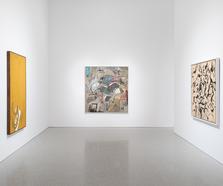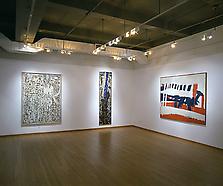“I can imagine an art that would have an innocuous surface where you don’t see anything at all of interest; you wouldn’t dream of looking at it with any idea that it could knock you over or have any power or anything, and then slowly you can begin to read into it all kinds of wonderful, imaginative things that you can see in it, and that could be a very marvelous form of art.” *
Born Rachmiel Resnick in 1917, Milton Resnick spent his childhood in the Ukraine, where he and his family were threatened by anti-Jewish pogroms during the Russian Civil War. The family fled first to Cuba and then to Brooklyn in 1922. He initially studied architectural drafting and lettering at a trade school, but could not find work when he finished school in the midst of the Depression in 1932. The following year, he enrolled in the fine arts program at the American Artist’s School, where he met Ad Reinhardt. In 1937, he met Willem de Kooning, who became a close friend, and in 1938, he joined the WPA. Resnick’s artistic pursuits were interrupted in 1940, when he was drafted into the army. When Resnick returned to New York after his discharge in 1945, he resumed painting and began meeting with de Kooning, Kline, Arshile Gorky, and other artists at the Waldorf Cafeteria for discussions about art and abstraction. From 1946 to 1948, Resnick lived in Paris, where he met Constantin Brancusi, Jean Hélion, and Tristan Tzara. He returned to New York, and in 1949, he was one of the founding members of the Club. That same year, Resnick was supposed to have his first solo exhibition, but the dealer cancelled it, causing a major setback to his career. In 1955, the Poindexter Gallery mounted his debut exhibition, but as a result of this six-year delay, Resnick has often been mislabeled a second-generation abstract expressionist.†
Resnick was a constant presence on the abstract expressionism scene, despite his ambivalence about being called an abstract expressionist. In 1951, he participated in the Ninth Street Show; his work was exhibited at the Stable Gallery; and in 1957, the Whitney Museum and the Jewish Museum selected his work for inclusion in the 1957 Annual Exhibition and Artists of the New York School, respectively. In 1959, he began to increase the scale of his work, creating massive paintings of small, thick gestures that covered the wall-sized








